+ データを開く
データを開く
- 基本情報
基本情報
| 登録情報 | データベース: PDB / ID: 7kml | ||||||
|---|---|---|---|---|---|---|---|
| タイトル | cryo-EM structure of SARS-CoV-2 spike in complex with Fab 15033-7, three RBDs bound | ||||||
 要素 要素 |
| ||||||
 キーワード キーワード | Viral protein/Immune System / SARS-CoV-2 / spike / Fab / Viral protein-Immune System complex | ||||||
| 機能・相同性 |  機能・相同性情報 機能・相同性情報symbiont-mediated disruption of host tissue / Maturation of spike protein / Translation of Structural Proteins / Virion Assembly and Release / host cell surface / host extracellular space / viral translation / symbiont-mediated-mediated suppression of host tetherin activity / Induction of Cell-Cell Fusion / structural constituent of virion ...symbiont-mediated disruption of host tissue / Maturation of spike protein / Translation of Structural Proteins / Virion Assembly and Release / host cell surface / host extracellular space / viral translation / symbiont-mediated-mediated suppression of host tetherin activity / Induction of Cell-Cell Fusion / structural constituent of virion / membrane fusion / entry receptor-mediated virion attachment to host cell / Attachment and Entry / host cell endoplasmic reticulum-Golgi intermediate compartment membrane / positive regulation of viral entry into host cell / receptor-mediated virion attachment to host cell / host cell surface receptor binding / symbiont-mediated suppression of host innate immune response / receptor ligand activity / endocytosis involved in viral entry into host cell / fusion of virus membrane with host plasma membrane / fusion of virus membrane with host endosome membrane / viral envelope / symbiont entry into host cell / virion attachment to host cell / SARS-CoV-2 activates/modulates innate and adaptive immune responses / host cell plasma membrane / virion membrane / identical protein binding / membrane / plasma membrane 類似検索 - 分子機能 | ||||||
| 生物種 |   Homo sapiens (ヒト) Homo sapiens (ヒト) | ||||||
| 手法 | 電子顕微鏡法 / 単粒子再構成法 / クライオ電子顕微鏡法 / 解像度: 3.8 Å | ||||||
 データ登録者 データ登録者 | Li, Z. / Rini, J.M. | ||||||
| 資金援助 |  カナダ, 1件 カナダ, 1件
| ||||||
 引用 引用 |  ジャーナル: J Mol Biol / 年: 2021 ジャーナル: J Mol Biol / 年: 2021タイトル: Tetravalent SARS-CoV-2 Neutralizing Antibodies Show Enhanced Potency and Resistance to Escape Mutations. 著者: Shane Miersch / Zhijie Li / Reza Saberianfar / Mart Ustav / James Brett Case / Levi Blazer / Chao Chen / Wei Ye / Alevtina Pavlenco / Maryna Gorelik / Julia Garcia Perez / Suryasree ...著者: Shane Miersch / Zhijie Li / Reza Saberianfar / Mart Ustav / James Brett Case / Levi Blazer / Chao Chen / Wei Ye / Alevtina Pavlenco / Maryna Gorelik / Julia Garcia Perez / Suryasree Subramania / Serena Singh / Lynda Ploder / Safder Ganaie / Rita E Chen / Daisy W Leung / Pier Paolo Pandolfi / Giuseppe Novelli / Giulia Matusali / Francesca Colavita / Maria R Capobianchi / Suresh Jain / J B Gupta / Gaya K Amarasinghe / Michael S Diamond / James Rini / Sachdev S Sidhu /     要旨: Neutralizing antibodies (nAbs) hold promise as therapeutics against COVID-19. Here, we describe protein engineering and modular design principles that have led to the development of synthetic ...Neutralizing antibodies (nAbs) hold promise as therapeutics against COVID-19. Here, we describe protein engineering and modular design principles that have led to the development of synthetic bivalent and tetravalent nAbs against SARS-CoV-2. The best nAb targets the host receptor binding site of the viral S-protein and tetravalent versions block entry with a potency exceeding bivalent nAbs by an order of magnitude. Structural studies show that both the bivalent and tetravalent nAbs can make multivalent interactions with a single S-protein trimer, consistent with the avidity and potency of these molecules. Significantly, we show that the tetravalent nAbs show increased tolerance to potential virus escape mutants and an emerging variant of concern. Bivalent and tetravalent nAbs can be produced at large-scale and are as stable and specific as approved antibody drugs. Our results provide a general framework for enhancing antiviral therapies against COVID-19 and related viral threats, and our strategy can be applied to virtually any antibody drug. #1: ジャーナル: bioRxiv / 年: 2020 タイトル: Tetravalent SARS-CoV-2 Neutralizing Antibodies Show Enhanced Potency and Resistance to Escape Mutations. 著者: Shane Miersch / Zhijie Li / Reza Saberianfar / Mart Ustav / James Brett Case / Levi Blazer / Chao Chen / Wei Ye / Alevtina Pavlenco / Maryna Gorelik / Julia Garcia Perez / Suryasree ...著者: Shane Miersch / Zhijie Li / Reza Saberianfar / Mart Ustav / James Brett Case / Levi Blazer / Chao Chen / Wei Ye / Alevtina Pavlenco / Maryna Gorelik / Julia Garcia Perez / Suryasree Subramania / Serena Singh / Lynda Ploder / Safder Ganaie / Rita E Chen / Daisy W Leung / Pier Paolo Pandolfi / Giuseppe Novelli / Giulia Matusali / Francesca Colavita / Maria R Capobianchi / Suresh Jain / J B Gupta / Gaya K Amarasinghe / Michael S Diamond / James Rini / Sachdev S Sidhu 要旨: Neutralizing antibodies (nAbs) hold promise as effective therapeutics against COVID-19. Here, we describe protein engineering and modular design principles that have led to the development of ...Neutralizing antibodies (nAbs) hold promise as effective therapeutics against COVID-19. Here, we describe protein engineering and modular design principles that have led to the development of synthetic bivalent and tetravalent nAbs against SARS-CoV-2. The best nAb targets the host receptor binding site of the viral S-protein and its tetravalent versions can block entry with a potency that exceeds the bivalent nAbs by an order of magnitude. Structural studies show that both the bivalent and tetravalent nAbs can make multivalent interactions with a single S-protein trimer, observations consistent with the avidity and potency of these molecules. Significantly, we show that the tetravalent nAbs show much increased tolerance to potential virus escape mutants. Bivalent and tetravalent nAbs can be produced at large-scale and are as stable and specific as approved antibody drugs. Our results provide a general framework for developing potent antiviral therapies against COVID-19 and related viral threats, and our strategy can be readily applied to any antibody drug currently in development. | ||||||
| 履歴 |
|
- 構造の表示
構造の表示
| ムービー |
 ムービービューア ムービービューア |
|---|---|
| 構造ビューア | 分子:  Molmil Molmil Jmol/JSmol Jmol/JSmol |
- ダウンロードとリンク
ダウンロードとリンク
- ダウンロード
ダウンロード
| PDBx/mmCIF形式 |  7kml.cif.gz 7kml.cif.gz | 786 KB | 表示 |  PDBx/mmCIF形式 PDBx/mmCIF形式 |
|---|---|---|---|---|
| PDB形式 |  pdb7kml.ent.gz pdb7kml.ent.gz | 646.4 KB | 表示 |  PDB形式 PDB形式 |
| PDBx/mmJSON形式 |  7kml.json.gz 7kml.json.gz | ツリー表示 |  PDBx/mmJSON形式 PDBx/mmJSON形式 | |
| その他 |  その他のダウンロード その他のダウンロード |
-検証レポート
| 文書・要旨 |  7kml_validation.pdf.gz 7kml_validation.pdf.gz | 3 MB | 表示 |  wwPDB検証レポート wwPDB検証レポート |
|---|---|---|---|---|
| 文書・詳細版 |  7kml_full_validation.pdf.gz 7kml_full_validation.pdf.gz | 3 MB | 表示 | |
| XML形式データ |  7kml_validation.xml.gz 7kml_validation.xml.gz | 121.4 KB | 表示 | |
| CIF形式データ |  7kml_validation.cif.gz 7kml_validation.cif.gz | 191.3 KB | 表示 | |
| アーカイブディレクトリ |  https://data.pdbj.org/pub/pdb/validation_reports/km/7kml https://data.pdbj.org/pub/pdb/validation_reports/km/7kml ftp://data.pdbj.org/pub/pdb/validation_reports/km/7kml ftp://data.pdbj.org/pub/pdb/validation_reports/km/7kml | HTTPS FTP |
-関連構造データ
- リンク
リンク
- 集合体
集合体
| 登録構造単位 | 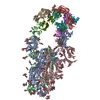
|
|---|---|
| 1 |
|
- 要素
要素
-タンパク質 , 1種, 3分子 ABC
| #1: タンパク質 | 分子量: 141170.250 Da / 分子数: 3 / 由来タイプ: 組換発現 由来: (組換発現)  遺伝子: S, 2 / 発現宿主:  Homo sapiens (ヒト) / 参照: UniProt: P0DTC2 Homo sapiens (ヒト) / 参照: UniProt: P0DTC2 |
|---|
-抗体 , 2種, 6分子 LMNHIJ
| #2: 抗体 | 分子量: 23366.900 Da / 分子数: 3 / 由来タイプ: 組換発現 / 由来: (組換発現)  Homo sapiens (ヒト) / 発現宿主: Homo sapiens (ヒト) / 発現宿主:  Homo sapiens (ヒト) Homo sapiens (ヒト)#3: 抗体 | 分子量: 23513.260 Da / 分子数: 3 / 由来タイプ: 組換発現 / 由来: (組換発現)  Homo sapiens (ヒト) / 発現宿主: Homo sapiens (ヒト) / 発現宿主:  Homo sapiens (ヒト) Homo sapiens (ヒト) |
|---|
-糖 , 3種, 45分子 
| #4: 多糖 | 2-acetamido-2-deoxy-beta-D-glucopyranose-(1-4)-2-acetamido-2-deoxy-beta-D-glucopyranose #5: 多糖 | beta-D-mannopyranose-(1-4)-2-acetamido-2-deoxy-beta-D-glucopyranose-(1-4)-2-acetamido-2-deoxy-beta- ...beta-D-mannopyranose-(1-4)-2-acetamido-2-deoxy-beta-D-glucopyranose-(1-4)-2-acetamido-2-deoxy-beta-D-glucopyranose #6: 糖 | ChemComp-NAG / |
|---|
-詳細
| 研究の焦点であるリガンドがあるか | N |
|---|---|
| Has protein modification | Y |
-実験情報
-実験
| 実験 | 手法: 電子顕微鏡法 |
|---|---|
| EM実験 | 試料の集合状態: PARTICLE / 3次元再構成法: 単粒子再構成法 |
- 試料調製
試料調製
| 構成要素 | 名称: SARS-CoV-2 spike protein in complex with Fab 15033-7 タイプ: COMPLEX / Entity ID: #1-#3 / 由来: RECOMBINANT | ||||||||||||
|---|---|---|---|---|---|---|---|---|---|---|---|---|---|
| 分子量 | 実験値: NO | ||||||||||||
| 由来(天然) | 生物種:  | ||||||||||||
| 由来(組換発現) | 生物種:  Homo sapiens (ヒト) Homo sapiens (ヒト) | ||||||||||||
| 緩衝液 | pH: 7.2 | ||||||||||||
| 緩衝液成分 |
| ||||||||||||
| 試料 | 濃度: 0.4 mg/ml / 包埋: NO / シャドウイング: NO / 染色: NO / 凍結: YES 詳細: The Fab and the spike protein was mixed at 3:1 molar ratio. The total concentration of the proteins was 0.4 mg/mL. | ||||||||||||
| 試料支持 | 詳細: current = 15 mA / グリッドの材料: COPPER / グリッドのサイズ: 400 divisions/in. / グリッドのタイプ: C-flat-2/2 | ||||||||||||
| 急速凍結 | 装置: FEI VITROBOT MARK IV / 凍結剤: ETHANE / 湿度: 100 % / 凍結前の試料温度: 277 K / 詳細: blotting force = 1 blotting time = 2.5 s |
- 電子顕微鏡撮影
電子顕微鏡撮影
| 実験機器 |  モデル: Titan Krios / 画像提供: FEI Company |
|---|---|
| 顕微鏡 | モデル: FEI TITAN KRIOS |
| 電子銃 | 電子線源:  FIELD EMISSION GUN / 加速電圧: 300 kV / 照射モード: FLOOD BEAM FIELD EMISSION GUN / 加速電圧: 300 kV / 照射モード: FLOOD BEAM |
| 電子レンズ | モード: BRIGHT FIELD / 倍率(公称値): 75000 X / 最大 デフォーカス(公称値): 2200 nm / 最小 デフォーカス(公称値): 1000 nm / Cs: 2.7 mm / アライメント法: COMA FREE |
| 試料ホルダ | 凍結剤: NITROGEN 試料ホルダーモデル: FEI TITAN KRIOS AUTOGRID HOLDER |
| 撮影 | 平均露光時間: 9 sec. / 電子線照射量: 38.08 e/Å2 フィルム・検出器のモデル: FEI FALCON IV (4k x 4k) 撮影したグリッド数: 1 / 実像数: 6431 |
- 解析
解析
| EMソフトウェア |
| ||||||||||||||||||||||||||||
|---|---|---|---|---|---|---|---|---|---|---|---|---|---|---|---|---|---|---|---|---|---|---|---|---|---|---|---|---|---|
| CTF補正 | タイプ: PHASE FLIPPING AND AMPLITUDE CORRECTION | ||||||||||||||||||||||||||||
| 対称性 | 点対称性: C3 (3回回転対称) | ||||||||||||||||||||||||||||
| 3次元再構成 | 解像度: 3.8 Å / 解像度の算出法: FSC 0.143 CUT-OFF / 粒子像の数: 93853 / クラス平均像の数: 1 / 対称性のタイプ: POINT | ||||||||||||||||||||||||||||
| 原子モデル構築 | プロトコル: RIGID BODY FIT / 空間: REAL | ||||||||||||||||||||||||||||
| 原子モデル構築 | 3D fitting-ID: 1 / Source name: PDB / タイプ: experimental model
| ||||||||||||||||||||||||||||
| 精密化 | 立体化学のターゲット値: GeoStd + Monomer Library + CDL v1.2 | ||||||||||||||||||||||||||||
| 原子変位パラメータ | Biso mean: 257.65 Å2 | ||||||||||||||||||||||||||||
| 拘束条件 |
|
 ムービー
ムービー コントローラー
コントローラー







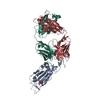
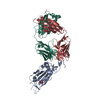





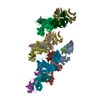
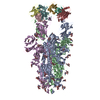

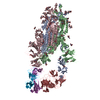
 PDBj
PDBj






